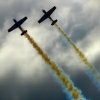I think it's just because in powered aircraft you have the engine to take you home. I know engines can fail, but I'm guessing mis-judgement in gliding (coming in too short or too long) occur more than engine failures in flights.
So I just think it takes more skill. You've got to know how to optimise the aircraft in flight. Throttles are quite basic... A push pull which even I can work well (to a point). Using the terrain, thermalling, etc. Just seems more to it and there's no backup engine.
I didn't say aerobatics in gliders require more talent, but probably more caution. Every time I go gliding there is usually someone talking about how the wings will snap off in high g or other aerobatic circumstances. And to a point I can definately see why. Loops and stalls don't seem to be too bad and can certainly be done, but much more than that in something as large as the Viking probably should be avoided. I don't know the exact aerobatic limits of motor or motorless gliders but it probably takes more attention to make sure you stay within the limits.
But I do agree that pilots should have experience at gliding before they qualify. Even if it's just a few hours of teaching then atleast they know how to respond to engine failure issues. My friend had an engine cut out once... But it was alright because he was in a glider

(yes, it did happen)




 ..!
..! ...
...  ...
...  ....!
....! ...
...  ...
...  ...!
...!














 (yes, it did happen)
(yes, it did happen)



 Just ask and usually they oblige
Just ask and usually they oblige 


